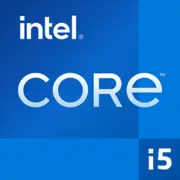Intel Core i5-1245U

Intel Core i5-1245U: A Balance Between Performance and Battery Life in 2025 Ultrabooks
(Analysis for users choosing laptops in March 2025)
Architecture and Process: The Hybrid Revolution of Alder Lake
The Intel Core i5-1245U processor, released in 2022, remains relevant for budget ultrabooks even in 2025 thanks to the hybrid Alder Lake architecture. Its key features include:
- 10 cores (2 P-cores + 8 E-cores) and 12 threads. P-cores (Performance) operate at frequencies up to 4.4 GHz in Turbo Boost mode and support Hyper-Threading, while energy-efficient E-cores (Efficient) handle background tasks, saving battery life.
- Intel 7 Process (formerly 10nm Enhanced SuperFin). This has reduced power consumption and improved transistor density.
- Intel Iris Xe Graphics (96 EU). The integrated graphics support 4K displays, AV1 encoding, and light gaming.
The hybrid architecture requires an optimized OS: Windows 11 (or newer) correctly distributes tasks between cores via Thread Director. For example, when working in Chrome, P-cores handle the tabs while E-cores manage background updates.
Power Consumption and TDP: 15 W for Thin Devices
The 15 W TDP makes the Core i5-1245U ideal for ultrabooks weighing up to 1.5 kg. However, actual consumption depends on the load:
- In idle mode, the processor reduces its frequency to 0.8–1.2 GHz, consuming 2–5 W.
- Under maximum load (e.g., video rendering), power briefly peaks at 55 W (PL2), but the cooling system of most ultrabooks isn't designed for prolonged operation at that level.
Tip: Choose laptops with dual-fan cooling (e.g., Dell XPS 13 Plus) — they maintain high Turbo frequencies longer.
Performance: From Office Work to Light Gaming
Geekbench 6 test results (1890/5417) show that the i5-1245U is 15–20% faster than the previous generation (i5-1135G7) in multi-threading tasks.
Real-World Scenarios:
1. Office Work:
- Running 30 Chrome tabs + Zoom + Excel — no delays thanks to E-cores.
- Re-encoding a 1-hour video in HandBrake: 12–14 minutes (compared to 18 minutes with i5-1135G7).
2. Multimedia:
- Streaming 4K HDR on YouTube: GPU load — 40–60%, CPU — 10–15%.
- Editing photos in Lightroom: filters apply without lag, but exporting a catalog of 100 images takes 3–4 minutes.
3. Gaming:
- CS2 (Full HD, low settings): 50–60 FPS.
- The Sims 4 (Full HD, medium settings): 40–45 FPS.
- For games with Iris Xe, RAM size is critical: dual-channel (LPDDR5) increases FPS by 20–30%.
Turbo Boost mode works effectively for short tasks (e.g., opening large PDFs), but for prolonged loads (over 5 minutes), the frequencies of P-cores drop to 3.2–3.5 GHz due to overheating.
Usage Scenarios: Who is the i5-1245U Designed For?
- Students and Office Workers: Multitasking, document handling, and video conferencing.
- Digital Nomads: Lightweight laptops (starting from 1.1 kg) and battery life.
- Casual Content Creators: Editing short videos in CapCut, photo processing.
- Casual Gamers: Playing games like Dota 2 or Minecraft.
Not Suitable For: 3D rendering, streaming AAA games, working with neural networks (e.g., Stable Diffusion).
Battery Life: Up to 12 Hours in Mixed Use
Laptops based on the i5-1245U (with a 60 Wh battery) demonstrate:
- 14–16 hours when reading PDFs or working in office applications (brightness 150 nits).
- 6–8 hours when watching YouTube (1080p).
- 3–4 hours under maximum load (e.g., video editing).
Power-saving Technologies:
- Intel Dynamic Tuning: automatically adjusts power based on network connection (e.g., lowering frequencies on battery).
- Adaptix Sleep: fast wake from sleep without increased consumption.
Tip: Disable Turbo Boost in power settings to extend battery life by 20–30% (P-core frequency will be limited to 2.4 GHz).
Comparison with Competitors
AMD Ryzen 5 7640U (Zen 4):
- Pros: Higher performance in multi-threaded tasks (by 10–15%), Radeon 740M is 25% faster than Iris Xe.
- Cons: More expensive (laptops from $1000), shorter battery life (by 1–2 hours).
Apple M2 (MacBook Air):
- Pros: Battery life up to 18 hours, cool operation.
- Cons: Limited compatibility with Windows software, no support for Thunderbolt 4.
Intel Core i5-1345U (Newer Generation):
- Performance gain of only 8–12%, but improved energy efficiency. However, laptops with the 13th generation cost $150–200 more.
Pros and Cons of the Core i5-1245U
Strengths:
- An ideal balance of price and performance for ultrabooks.
- Supports Thunderbolt 4 (for connecting external GPUs or 8K monitors).
- Good integration with Windows 11.
Weaknesses:
- Limited multi-threaded performance compared to Ryzen 5.
- Iris Xe graphics lag behind Radeon 700M and Apple M2.
- Heating under prolonged load in thin chassis.
Laptop Selection Recommendations
1. Type of Device: Ultrabooks (Asus ZenBook 14, HP EliteBook 840 G9) or compact business laptops (Lenovo ThinkPad X1 Carbon).
2. Price: $800–$1200. Models priced below $800 often cut corners on screens (TN panels) or SSDs (256 GB).
3. What to Look For:
- Screen: At least IPS, 300 nits, 100% sRGB.
- RAM: 16 GB LPDDR5 (soldered).
- SSD: 512 GB NVMe (preferably with PCIe 4.0).
- Ports: 2x Thunderbolt 4 for future upgrades.
Example: Acer Swift 5 (2025) for $999 — 14-inch OLED screen, 16 GB RAM, weight 1.2 kg.
Final Conclusion
The Intel Core i5-1245U is an optimal choice for those seeking an affordable ultrabook (up to $1200) with 8–12 hours of battery life and sufficient performance for work, study, and light creativity. It falls behind the newer Ryzen 7000 and Apple M2 in demanding tasks but excels in price, portability, and compatibility with the Windows ecosystem. If you need a laptop that won't run out of battery on a plane and can handle basic video editing — this is your option.
Basic
CPU Specifications
Memory Specifications
GPU Specifications
Miscellaneous
Benchmarks
Compared to Other CPU
Share in social media
Or Link To Us
<a href="https://cputronic.com/cpu/intel-core-i5-1245u" target="_blank">Intel Core i5-1245U</a>